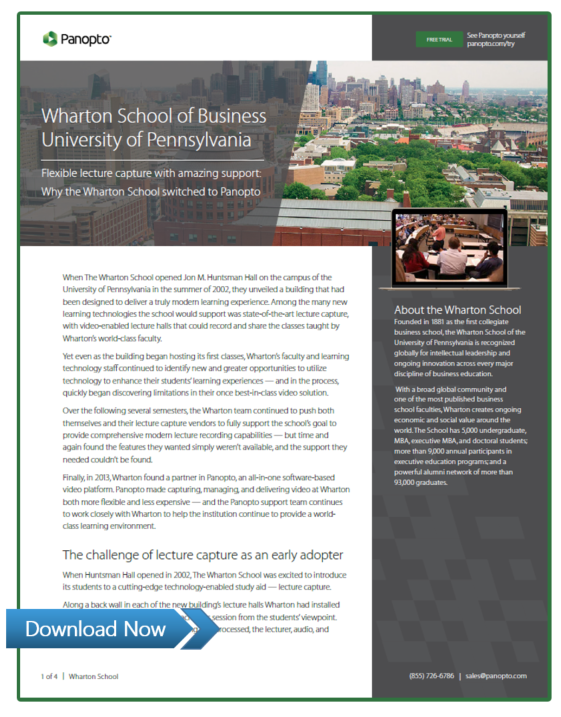- Academic Technology
Flexibility & Support: Why Wharton Switched Lecture Capture Platforms
When Huntsman Hall opened in 2002, The Wharton School was excited to introduce its students to a cutting-edge technology-enabled study aid — lecture capture.
Along a back wall in each of the new building’s lecture halls, Wharton had installed a fixed camera that would record each class session from the students’ viewpoint. After each class ended and its recording had processed, the lecturer, audio, and the projection screens at the front of the class would all be available for students to rewatch and study.
Especially for early adopters of lecture recording technology, it wasn’t an uncommon setup — but it was also one with a number of drawbacks. The single-source video recording could only capture video in low-fidelity, meaning any time the presenter wrote on the whiteboard or had a white background on their PowerPoint slide, the whole image was illegibly bright. Nor was the system flexible — the fixed stationary cameras could only provide a back-row view of the classroom and added little more to the learning experience.
Still, students valued the lecture recordings and The Wharton School was keen to improve upon what had clearly been a worthwhile first step. After several years of working with their first lecture capture solution, Wharton’s Classroom Technology staff made the move to another hardware-based lecture recording system that promised greater flexibility.
Wharton’s new solution quickly enabled faculty to produce higher quality recordings and add rich-media elements to their videos, a real enhancement for lecturers and students alike. But for Wharton’s Classroom Technology team, the new system still wasn’t without limitations.
First among the challenges was simple availability. The specialized hardware and servers required meant increased costs, which in turn meant Wharton could only deploy the new technology in a limited number of rooms. Many faculty members, excited to use the new system, instead found that the room they were teaching in wouldn’t have the new service available.
And while at first faculty in the newly-equipped classrooms were pleased with the system’s improved flexibility, in the semesters that followed many soon discovered the new recording solution didn’t quite support all the ways they wanted to use video in the classroom.
From Hardware to Software: Bringing High-Quality Lecture Recording to Every Classroom
Throughout the school’s early experiences in supporting lecture capture, The Wharton School’s Public Technology team took a proactive role, working closely with the school’s lecture capture vendors to share constructive criticism, bug reports, and feature requests. As they did, the team came to find that while the technology itself was important when it came to lecture capture, it was the level of support provided for that technology that was most valuable.
In order to innovate at the pace they wanted, the school needed a partner they could trust; one that would work with them side-by-side to deliver a high-quality experience. And according to Jimmy Lieu, Director of Information Technology at The Wharton School of the University of Pennsylvania, that’s when the school discovered Panopto.
Initially, Wharton was attracted to Panopto for its flexible, online video platform. With Panopto, the school would be able to produce and manage its lecture recordings from any desktop PC, using the video recorders of their choice — a welcome change from the specialized servers and media equipment required by past solutions.
Relying on standard PCs, Wharton’s IT staff could have Panopto installed in any classroom they chose, and they could add a classroom at any point whether for a day or the rest of the semester. That meant that no professor who wanted lecture capture would be left out.
Better still, scheduled remote recording — all managed centrally in the Panopto platform by the school’s Public Technology department — meant that professors needed only to walk into the lecture hall at their regularly scheduled time, open their slide presentation, and give their lecture as usual. Panopto automatically took care of producing and uploading the video and the professor didn’t need to do anything to make sure the lecture was captured flawlessly. Even if the professor did not schedule a remote recording, they still had the ability to start a recording from the touch panel in the classroom.
Relying on software instead of hardware, Panopto also meant staff supporting lecture capture could make their own technology choices. Wanting to deliver the very highest caliber lecture capture, Wharton had opted to build their own PCs with high-end video cards. This approach not only allowed the IT department to save budget over buying proprietary media racks, but meant that most any malfunction could be solved by simply swapping out a computer — a process made all the easier with Panopto, which enables system administrators to monitor every classroom’s lecture recording system status in real time from any web browser.
Remote recording also allowed the IT staff to limit access to the capture computers, delivering a more reliable service for their faculty. Freed from the need to have technical staff present for each lecture to be captured, Wharton was able to secure their mission-critical computers. This eliminated the guesswork for IT who could trust that Panopto was running in a stable and secure environment.
 To learn more about how The Wharton School used Panopto to expand and simplify their lecture capture implementation, download the complete case study today.
To learn more about how The Wharton School used Panopto to expand and simplify their lecture capture implementation, download the complete case study today.
Interested in upgrading your institution’s lecture capture to a software-based video content management system? Contact a member of our team today to request a free trial.


